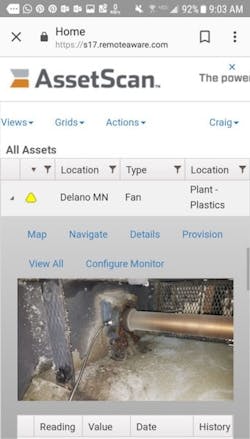Craig Truempi, CMRP, is director of Industrial Internet of Things reliability for ATEK Co. Truempi can be reached at [email protected].
New technology is making it easier and cheaper for small and large water and wastewater treatment plants to solve machinery problems. The use of vibration or ultrasonic sensors with embedded cellular connectivity all-in-one devices is gaining popularity in the industry. This technology pre-processes the data in the device with ultrasonic or vibration technology, making it easy to understand for plant personnel with limited experience.
The technician or plant operator attaches the sensor on a suspect bearing using a strong 34-lb pull magnet. Within minutes, data is pre-processed in the device, and a summary point is posted to the cloud. In the cloud, the data automatically is compared to thresholds. If a high reading is detected, a text message alerts plant personnel with a descriptive message similar to the following: “Date/Time: Critical Alert: No. 4 Recirculation Pump Bearing, 29.2 G’s.”
In this example, going to the asset for a human inspection to ensure the sensor is mounted correctly is the first step to resolving the condition. The employee may also look for the presence of smoke, visible vibration or any noise, or if the bearing is hot. Upon evaluation, grease could be added to the bearing, and within minutes the employee would get a status alert.
Plant personnel often are too busy with day-to-day work, interrupted by reactive maintenance work, to notice what in hindsight can seem so simple.
ROI from Technology
It is important to remember that not all technology is created equal. The right technology should be simple, yet have ability to grow with the facility, in both size and capability. The decision to implement technology must consider installation and training costs. Some technology, specifically around ultrasonic and vibration, can get complex, and it is unclear what action is necessary. Many technologies also take time to configure, learn and maintain.
Starting with a technology that leverages existing infrastructure and can be shared across multiple assets is a viable strategy. With the cellular sensor example, the unit can be moved from suspect asset to suspect asset, and from site to site, thus enabling multiple quick finds and multiple quick wins to provide a return on investment. The proceeds from these quick wins can be used to self-fund further improvement investments.
Setting Up for Savings
The ultrasonic or vibration sensor with embedded cellular is built for purpose and designed for an industrial plant floor. This setup is as simple as a consumer cell phone—turn it on and it is immediately collecting and transmitting data. Just like a cell phone is set up at the provider store or kiosk, the ultrasonic or vibration sensor is set up before shipment. Settings can be customized as well.
With this technology, the plant location must have cellular coverage because it uses the existing cellular infrastructure. By using that network, this sensor does not need any wires, Wi-Fi passwords, network IDs, firewalls or additional gateways. There is no software or app to install or update as everything can be accessed through the website, including profile editing, adding phone numbers for alerts and setting alert levels.
Through this portal, you also can get an overview on the status of devices, view historical trends, manage users, add pictures and movies clips, and export data, among other tasks.
Given an existing water and wastewater treatment plant and aging machinery, Inspections can help improve machinery reliability. With these, one can find early warnings of impending problems and repair them while they are small; lubrication is a common and easy fix. Loose bolts or components, misalignment, imbalance, and worn or defective bearings are other common faults. An ultrasonic or vibration sensor can be used to detect all these problems.
Why These Faults?
These issues occur at random times, meaning they are not predictable based on time or runtime. Because they can be consistently detected weeks to months in advance, allowing enough time to plan and schedule the repair can prevent a much larger, more damaging event.
Given the existing infrastructure of cellular networks and smartphones, a cellular sensor sending text messages and emails to existing smartphones and computers is a budget-friendly way to keep track of machinery conditions while using the existing cloud storage for data history, visualization
and analytics.


